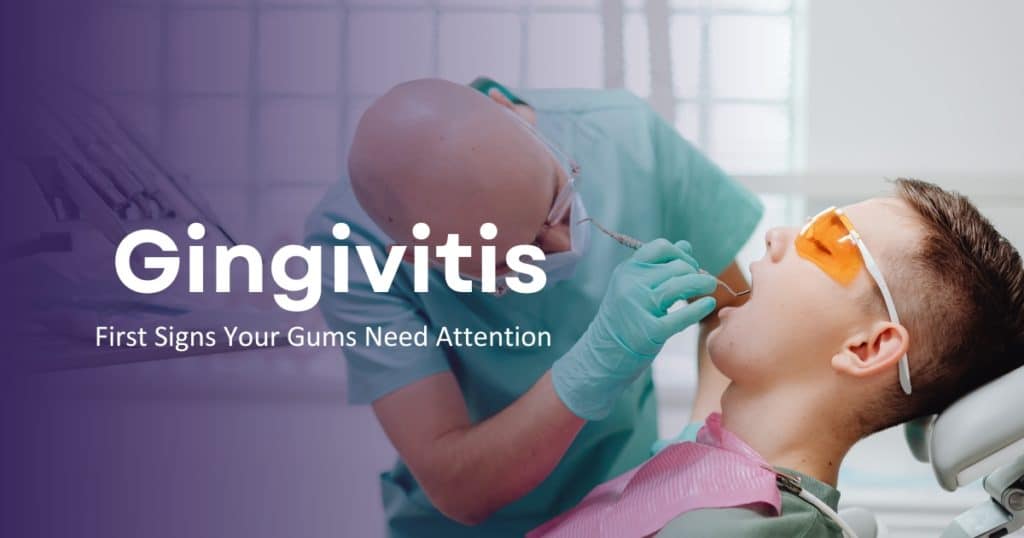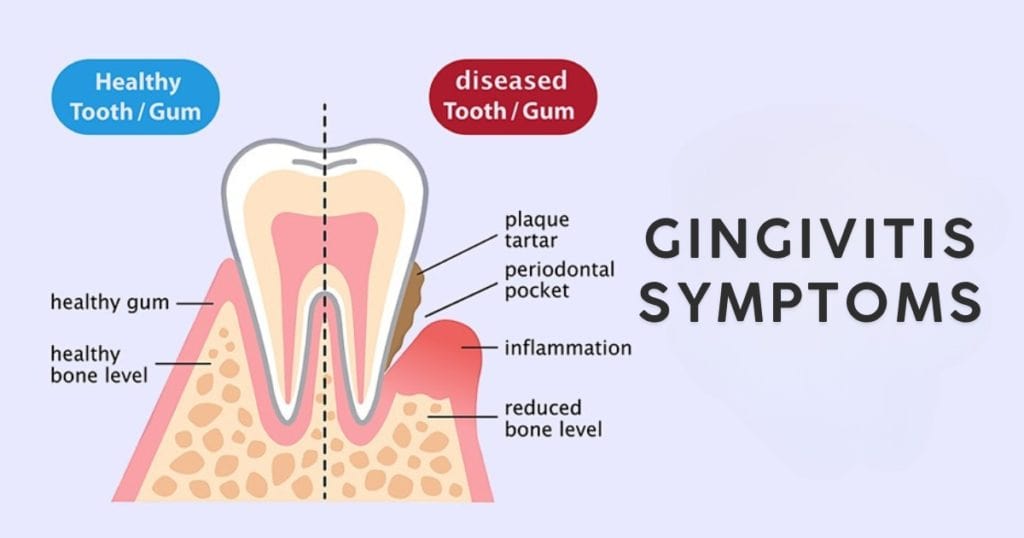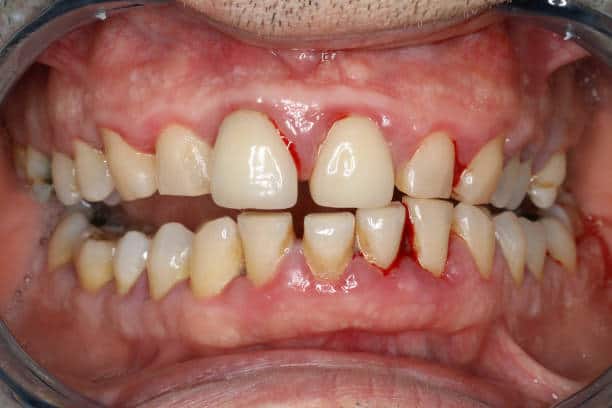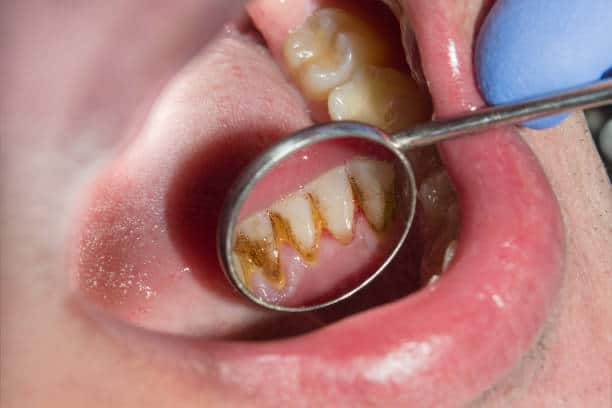Gingivitis – Causes, Symptoms, Treatment & Prevention

Gingivitis Early Signs : Bleeding Gums, Inflammation & What to Do
Gingivitis is an early and common form of gum disease that occurs when plaque, a soft, sticky film of bacteria, builds up on the teeth and along the gumline. This bacterial accumulation irritates the gums, leading to inflammation, redness, and swelling. One of the most noticeable signs of gingivitis is bleeding gums, especially during brushing or flossing. Although gingivitis is usually mild in its initial stages, it serves as a warning sign that the gums are not healthy.
If left untreated, gingivitis can advance to periodontitis, a more severe and irreversible stage of gum disease that can damage the tissues and bone supporting the teeth, eventually leading to tooth mobility or loss. The progression from gingivitis to periodontitis is gradual, but it can be prevented with consistent and proper oral hygiene.
Effective prevention and treatment of gingivitis rely on maintaining good daily habits, such as brushing twice a day, flossing regularly, and using an antibacterial mouthwash. In addition, professional dental cleanings help remove hardened plaque (tartar) that cannot be eliminated by brushing alone. Early detection and intervention are essential to stop the disease from advancing and to preserve long-term oral health.
What Is Gingivitis?
Gingivitis is the inflammation of the gum tissue caused primarily by plaque buildup. When plaque (a sticky bacterial film) accumulates around your teeth, it irritates your gums. If not removed by brushing and professional cleaning, this plaque hardens into tartar (calculus), a rough surface that harbours bacteria.
As a result, your gums become swollen, red, and tender. You may notice bleeding while brushing, bad breath, or mild pain. The good news is that this early form of gum disease is reversible. With proper gingivitis treatment and improved oral hygiene, you can fully restore gum health.
Gingivitis Causes
Gingivitis primarily develops due to poor oral hygiene, which allows plaque, a sticky film of bacteria, to accumulate on the teeth and along the gumline. Over time, this buildup irritates the gums, causing inflammation and bleeding. While plaque is the main culprit, several other factors can increase the risk of developing gingivitis.
1. Plaque and Tartar Accumulation
The most common cause of gingivitis is the buildup of plaque on tooth surfaces. If not removed through daily brushing and flossing, plaque hardens into tartar (calculus), which cannot be eliminated by regular cleaning. Tartar irritates the gum tissue, triggering inflammation, swelling, and bleeding during brushing or flossing.
2. Poor Oral Hygiene Habits
Inconsistent brushing and neglecting to floss allow bacteria to thrive in the mouth. As these bacteria multiply, they release toxins that irritate the gums, leading to inflammation, bad breath (halitosis), and early gum disease. Poor oral hygiene habits also make it easier for tartar to form, further worsening the condition.
3. Hormonal and Medical Factors
Hormonal changes that occur during puberty, pregnancy, menstruation, or menopause can make the gums more sensitive and prone to inflammation—a condition sometimes referred to as gingival hyperplasia. In addition, systemic health conditions such as diabetes, nutritional deficiencies, dry mouth, or a weakened immune system can reduce the body’s ability to fight infection, increasing susceptibility to gingivitis.
4. Tobacco Use and Smoking
Smoking and tobacco use are significant risk factors for gum disease. Nicotine restricts blood flow to the gums, slowing down healing and masking early warning signs such as bleeding or tenderness. As a result, smokers often experience more severe gum problems and slower recovery after treatment.
5. Misaligned Teeth or Faulty Dental Work
Crooked or crowded teeth, along with poorly fitted crowns, fillings, or bridges, can create hard-to-clean areas where plaque easily accumulates. These areas trap food particles and bacteria, leading to localised gum inflammation, bleeding, and infection if not properly managed.

Gingivitis Symptoms
Gingivitis usually develops gradually, and its initial symptoms may be mild or easily overlooked. However, early recognition and intervention are essential to prevent the condition from advancing to periodontitis, a more serious and irreversible form of gum disease.
The most common signs of gingivitis include red, swollen, and tender gums that may bleed during brushing or flossing. Many individuals also experience persistent bad breath (halitosis) or a metallic or unpleasant taste in the mouth due to bacterial buildup along the gumline.
As inflammation progresses, gum recession can occur, causing the teeth to appear longer. Small gaps or pockets may also form between the teeth and gums, creating spaces where plaque and bacteria accumulate. These changes indicate that gingival inflammation is advancing and requires professional attention.
Common Clinical Gingivitis Symptoms
- Red, tender, or swollen gums
- Bleeding during brushing or flossing
- Persistent bad breath or unpleasant taste
- Gum recession or visible gaps between teeth and gums
- Sensitivity or discomfort along the gumline
Less Common or Advanced Gingivitis Symptoms
In more advanced or untreated cases, gingivitis can present with additional symptoms that suggest a transition toward periodontitis or more severe gum involvement. These include:
- Dark red or purplish gum colour, indicating deeper inflammation
- Gums that feel spongy or detach from the teeth when touched
- Formation of deep periodontal pockets that trap food and bacteria
- Loose or shifting teeth due to loss of supporting tissues
- Changes in bite alignment or difficulty chewing
- Pus discharge between teeth and gums, signalling infection
These advanced signs reflect ongoing damage to the periodontal structures that support the teeth. At this stage, professional evaluation and treatment are crucial for controlling the infection, halting tissue destruction, and preventing tooth loss.

Gingivitis Stages: From Gingivitis to Periodontitis
Gum disease develops gradually, beginning with mild inflammation and, if left untreated, progressing to advanced tissue and bone damage. Understanding the stages helps identify early warning signs and the importance of timely dental care.
Gingivitis Stages 1: Healthy Gums
Healthy gums are the foundation of good oral health.
- Colour and texture: Gums appear firm, pink, and well-contoured around each tooth.
- No bleeding: Healthy gums do not bleed during brushing or flossing.
- Tight attachment: The gums fit snugly around the teeth, forming a natural barrier that keeps bacteria from reaching the underlying bone and connective tissues.
- No inflammation or discomfort: There are no signs of swelling, redness, or tenderness.
Maintaining this stage requires consistent oral hygiene practices—brushing twice daily, flossing, and routine professional cleanings.
Gingivitis Stages 2: Early Gum Disease
Gingivitis represents the initial stage of gum disease and is caused by the accumulation of plaque along the gumline.
- Visible inflammation: Gums may appear red, puffy, or slightly swollen.
- Bleeding: Mild bleeding often occurs during brushing or flossing.
- Mild irritation: Some tenderness or sensitivity may develop, especially near the gum margins.
- Reversibility: At this stage, no permanent bone or tissue damage has occurred. With proper oral hygiene and professional cleaning, gingivitis is fully reversible.
Gingivitis Stage 3: Early Periodontitis
When gingivitis is left untreated, it can advance to early periodontitis, where bacterial infection extends deeper below the gumline.
- Pocket formation: Gums begin to pull away from the teeth, forming small pockets that trap plaque and tartar.
- Early bone loss: Minor bone destruction may begin, weakening tooth support.
- Mild gum recession: Gums start receding, making teeth appear slightly longer.
- Persistent inflammation: The gums remain red, swollen, and prone to bleeding.
At this point, damage becomes irreversible, but disease progression can still be controlled with timely dental treatment such as scaling and root planing.
Gingivitis Stages 4: Advanced Periodontitis
This is the most severe form of gum disease and involves significant destruction of the tissues and bone supporting the teeth.
- Deep periodontal pockets: Gums detach further from the teeth, allowing more bacteria to accumulate.
- Severe bone loss: The supporting bone weakens, causing tooth mobility.
- Gum recession: Gums pull away noticeably, exposing tooth roots.
- Functional issues: Teeth may shift, loosen, or even fall out. Chewing can become painful or difficult.
- Treatment complexity: Managing this stage may require advanced periodontal therapy, including deep cleaning (scaling and root planing), antibiotic therapy, or surgical interventions to restore gum and bone health.
Early recognition and intervention are crucial. Detecting gingivitis before it progresses can prevent permanent damage and preserve both gum and bone health.
Gingivitis vs. Periodontitis
| Aspect | Gingivitis | Periodontitis |
|---|---|---|
| Definition | The early and reversible stage of gum disease involving gum inflammation. | The advanced and irreversible stage affecting bone and supporting tissues. |
| Primary Cause | Plaque buildup on teeth and gumline. | Untreated gingivitis progressing deeper into tissues. |
| Affected Areas | Only soft gum tissue. | Gums and underlying bone. |
| Common Symptoms | Red, swollen gums, bleeding, mild bad breath. | Receding gums, deep pockets, loose teeth, persistent bad breath. |
| Pain Level | Mild or painless. | Discomfort and pain while chewing. |
| Reversibility | Completely reversible. | Irreversible but can be controlled. |
| Treatment | Professional cleaning + good home care. | Deep cleaning, antibiotics, or surgery. |
| If Untreated | May progress to periodontitis. | Tooth mobility and possible tooth loss. |
Causes of Gum Swelling and Bleeding
Gum swelling and bleeding are often the first visible signs of gum inflammation. The most common cause is poor oral hygiene, which allows plaque, a sticky bacterial film, to accumulate along the gumline. If not removed, this plaque hardens into tartar and irritates the gums, leading to gingivitis, the earliest stage of gum disease. In more advanced cases, the condition can progress to periodontitis, where deeper tissues and bone become affected.
However, gum swelling and bleeding can also result from other health, lifestyle, and dental factors. Below are the most common causes explained in detail:
1. Plaque and Tartar Buildup
- Plaque forms when bacteria in the mouth combine with food particles and saliva.
- If not removed through regular brushing and flossing, it hardens into tartar (calculus).
- Tartar irritates the gums, causing redness, swelling, and bleeding during brushing or flossing.
- This is the primary cause of gingivitis and can lead to periodontitis if neglected.
2. Aggressive or Improper Brushing Techniques
- Brushing too hard or using a toothbrush with stiff bristles can damage delicate gum tissue.
- This causes the gums to recede and may trigger bleeding even in the absence of infection.
- Using a soft-bristled toothbrush and gentle, circular motions helps protect the gums.
3. Vitamin C Deficiency (Scurvy)
- A lack of vitamin C affects collagen production, which weakens gum tissues and blood vessels.
- This can lead to swollen, tender gums that bleed easily, even with minimal irritation.
- Consuming citrus fruits, leafy greens, and supplements (if prescribed) can help restore gum health.
4. Hormonal Changes
- Fluctuations in hormones during puberty, pregnancy, menstruation, or menopause increase blood flow to the gums.
- This heightened sensitivity makes the gums more prone to inflammation and bleeding, even with normal oral hygiene.
- Such cases are referred to as hormone-related gingivitis and require gentle care and monitoring.
5. Poor-Fitting Dental Crowns or Bridges
- Ill-fitting dental restorations can trap food and plaque around the gumline.
- This localised irritation leads to redness, swelling, and sometimes gum overgrowth near the affected area.
- Correcting or adjusting these restorations can prevent further inflammation.
6. Systemic Conditions (e.g., Diabetes)
- Individuals with uncontrolled diabetes are more susceptible to gum infections due to impaired healing and immune response.
- Other systemic conditions, such as blood disorders or immune deficiencies, can also contribute to gum bleeding.
- Managing these underlying conditions is essential to maintaining gum health.
7. Medications and Vitamin K Deficiency
- Certain medications, such as blood thinners, antihypertensives, or anticonvulsants, may cause gum swelling or bleeding.
- A deficiency in vitamin K, which supports blood clotting, can also increase bleeding tendency.
- Regular dental check-ups and communication with healthcare providers help manage such side effects safely.


Professional Gingivitis Treatment at Dr White Dental Care
Gingivitis, the early stage of gum disease, can be reversed with timely professional care. The main goal of treatment is to eliminate plaque and tartar buildup, control infection, and restore gum health. Below is an overview of the most effective professional treatments for gingivitis, what you can expect during your visit, and how to maintain long-term gum health.
1. Dental Cleaning (Scaling and Polishing)
The first step in treating gingivitis is a professional dental cleaning, also known as scaling and polishing.
- During this procedure, plaque and tartar are gently removed from both above and below the gumline.
- It helps eliminate bacteria responsible for gum inflammation and allows the gums to heal naturally.
- Regular cleanings every six months can significantly reduce the risk of recurring gingivitis.
2. Deep Cleaning (Scaling and Root Planing)
For patients showing signs of early gum detachment or mild periodontitis, dentists recommend scaling and root planing, commonly referred to as a deep cleaning.
- Scaling removes hardened tartar and bacterial deposits.
- Root planing smooths the root surfaces, helping the gums reattach to the teeth and preventing further bacterial buildup.
- This treatment promotes healing and reduces gum pockets that trap bacteria.
3. Laser and Non-Surgical Gum Therapy
At our Madinaguda and Nizampet clinics, we use advanced laser-assisted gum therapy for faster and more comfortable recovery.
- Laser treatment targets infected areas precisely, disinfecting and sealing the tissues.
- It promotes natural healing, reduces bleeding, and minimises discomfort compared to traditional methods.
- This non-surgical approach is especially beneficial for patients with early to moderate gum disease.
4. Dental Work Repair and Adjustments
Improperly fitting crowns, bridges, or fillings can irritate gums and trap plaque.
- Your dentist will check for any dental restorations that may be contributing to inflammation.
- Replacing or adjusting these restorations helps prevent bacterial accumulation and supports gum healing.
5. Antimicrobial Mouthwash and Medications
Your dentist may prescribe antimicrobial mouthwashes, antibiotics, or desensitising gels to control infection and inflammation.
- Medicated rinses help reduce bacterial levels between professional cleanings.
- In severe cases, antibiotics may be prescribed to manage persistent infection.
- Maintaining good home care with these aids supports faster recovery and prevents recurrence.
6. Surgical Treatment (For Advanced Cases)
If gingivitis progresses to periodontitis or bone loss occurs, surgical procedures may be recommended.
- Treatments such as flap surgery, bone grafting, or guided tissue regeneration can help restore damaged bone and gum tissue.
- A periodontist (gum specialist) will determine the best surgical option depending on your oral health condition.
What to Expect During Gingivitis Treatment?
1. Comprehensive Dental Evaluation
Your dentist will begin with a detailed assessment:
- Checking gum colour, texture, and bleeding levels
- Measuring pocket depths around teeth
- Taking X-rays (if necessary) to evaluate bone health
2. Oral Hygiene Guidance
After treatment, you’ll receive personalised instructions for maintaining gum health:
- Proper brushing and flossing techniques
- Recommended toothpaste and mouthwash
- Diet and lifestyle tips to minimise inflammation
3. Follow-Up and Maintenance
Regular follow-up visits are crucial to monitor healing and prevent recurrence.
- Most patients benefit from professional cleanings every 3–6 months, depending on gum condition.
- Ongoing maintenance helps ensure long-term results and a healthy smile.
Can Gingivitis Be Cured Permanently?
Yes. Gingivitis can be cured permanently, provided it’s detected early and treated properly. The key to a full recovery lies in professional dental cleaning followed by consistent home care to prevent bacterial buildup from returning.
At Dr White Dental Care, most patients begin noticing visible improvement, reduced swelling, bleeding, and tenderness within two weeks of their first treatment session. With ongoing maintenance, healthy gums can be fully restored and kept that way for life.
How to Prevent Gingivitis from Returning?
1. Maintain Consistent Oral Hygiene
- Brush your teeth twice a day using a soft-bristle toothbrush and fluoride toothpaste.
- Floss daily to remove plaque between teeth where brushing can’t reach.
- Rinse with an antimicrobial or fluoride mouthwash to control bacterial growth.
- Consider using an electric toothbrush for better plaque removal and gum stimulation.
2. Schedule Regular Dental Check-Ups
- Visit your dentist every six months (or as recommended) for professional cleanings.
- Regular check-ups allow your dentist to monitor gum health, remove tartar buildup, and detect early signs of inflammation.
- Consistent follow-ups help prevent gingivitis from progressing to periodontitis, a more serious gum disease.
3. Avoid Smoking and Tobacco Use
- Smoking weakens gum tissue, reduces oxygen supply, and delays healing.
- Quitting smoking can dramatically improve gum response to treatment and lower the risk of recurrence.
4. Limit Sugary and Processed Foods
- Frequent consumption of sweets, soft drinks, and processed foods feeds harmful bacteria in the mouth.
- Choose a balanced diet rich in vitamin C, vitamin D, and calcium to strengthen gum and bone health.
- Stay hydrated — water helps wash away food particles and bacteria.
5. Use Dentist-Recommended Mouthwashes or Medications
- Use the prescribed antimicrobial mouthwash to control bacteria and reduce gum inflammation.
- Follow any additional medication or oral care advice given by your dentist.
- Avoid over-the-counter rinses that contain alcohol, as they may irritate sensitive gums.
With early detection, professional treatment, and consistent care, gingivitis can be completely reversed and prevented from recurring. A healthy oral care routine, supported by regular dental visits, ensures your gums remain strong, pink, and free from infection.
Best Toothpaste and Mouthwash for Gingivitis
Choosing the right oral care products is key to reversing gingivitis and maintaining healthy gums.
Toothpaste for Gingivitis
Look for toothpaste that helps reduce plaque, strengthen enamel, and soothe gums:
- Fluoride: Protects enamel and prevents decay.
- Stannous Fluoride: Fights bacteria, reduces bleeding, and relieves sensitivity.
- Antibacterial Agents (like zinc or herbal extracts): Control plaque and inflammation.
- Gentle Formulas: Avoid harsh whitening pastes; use options for sensitive gums.
Mouthwash for Gingivitis
A therapeutic mouthwash complements brushing by targeting bacteria and reducing gum inflammation:
- Chlorhexidine: Prescription rinse for active gingivitis (short-term use).
- Essential Oils (Thymol, Eucalyptol, Menthol): Reduce plaque and freshen breath.
- Cetylpyridinium Chloride (CPC): Mild antiseptic for daily use.
- Alcohol-Free Options: Ideal for sensitive or dry mouths.
Dentist’s Recommendation
At Dr White Dental Care (Madinaguda & Nizampet), dentists recommend personalised toothpaste and mouthwash combinations based on your gum condition and sensitivity level. Consistent use, along with professional cleanings every six months, ensures long-term gum health.
How to Keep Gums Healthy?
Keeping your gums healthy requires consistent oral hygiene, a balanced lifestyle, and regular dental visits. With the right habits, gingivitis and other gum problems can be easily prevented.
At-Home Oral Care
- Brush Properly: Brush twice a day for at least two minutes using fluoride toothpaste and a soft-bristle brush. Hold it at a 45° angle to the gumline and use short, gentle strokes. Electric toothbrushes can further enhance plaque removal.
- Clean Between Teeth: Floss daily or use interdental brushes or a water flosser to remove plaque and food particles that brushing can’t reach.
- Use Fluoride: Fluoride strengthens enamel and reduces bacterial buildup. Your dentist may recommend a fluoride rinse or treatment for added protection.
Lifestyle and Diet Habits
- Eat Nutritious Foods: Include fruits, vegetables, whole grains, and calcium-rich foods. Limit sugary and starchy foods that encourage plaque formation.
- Stay Hydrated: Drink plenty of water throughout the day to wash away food debris and promote saliva flow, which naturally protects gums.
- Quit Smoking: Tobacco use weakens the immune system and significantly increases the risk of gum disease.
- Manage Stress: Chronic stress affects immunity and can worsen gum inflammation. Practice relaxation techniques like deep breathing, yoga, or exercise.
Professional Dental Care
- Regular Check-Ups: Visit your dentist every six months for a professional cleaning and oral examination.
- Scaling and Polishing: Professional cleanings remove plaque and tartar buildup that brushing alone cannot.
Conclusion
Gingivitis may appear mild, but it is the earliest warning sign of gum disease, and, if left untreated, can progress to periodontitis. The good news is that when detected early, gingivitis is completely reversible with professional care and consistent oral hygiene.
At Dr White Dental Care, our approach is centred on prevention, precision, and patient comfort. We combine advanced diagnostic techniques with gentle, evidence-based treatments from scaling and root planing to non-surgical gum therapy, ensuring your gums regain their natural health and strength.
Our team also emphasises patient education, helping you understand the best ways to maintain lasting oral wellness at home.
Schedule your appointment today at our Madinaguda or Nizampet clinic to experience compassionate, expert dental care that keeps your gums healthy, breath fresh, and smile radiant with confidence.
FAQ'S
Gingivitis improves when plaque and tartar are removed and the gums receive consistent care. Professional cleaning, proper brushing, daily flossing, and using an antiseptic mouthwash allow the gums to heal and return to a healthy state.
The primary cause is plaque accumulation along the gumline. When plaque isn’t removed regularly, it hardens into tartar and triggers inflammation in the gums.
Mouthwash can reduce bacteria and soothe inflamed gums, but it works as a supportive measure. Gingivitis is reversed through professional cleaning and a proper home care routine.
Brush gently with a soft-bristled toothbrush using small circular motions. Focus on the gumline, take your time, and avoid harsh scrubbing that can irritate already inflamed gums.
A dentist removes plaque and tartar through scaling, evaluates gum health, and provides guidance on effective home care. In some cases, medicated rinses or specialised cleanings may be recommended.
This guideline suggests brushing twice a day, for two minutes each time, and visiting the dentist two times a year for preventive care.
A deficiency in vitamin C can weaken gum tissues, making them more prone to inflammation and bleeding.
Stage 1 shows red, swollen gums that may bleed during brushing or flossing. At this point, the condition is limited to the gum tissue and does not involve bone loss.
Yes. Stress affects the immune system, making it harder for the body to control the bacteria that cause gum inflammation.
The number refers to gum pocket depth measured during a periodontal exam. A reading of “2” typically indicates healthy or slightly irritated gums.
Brushing twice daily is effective when paired with daily flossing and routine dental visits. This combination keeps plaque levels under control.
Leaving a small amount of toothpaste for short periods can help with sensitivity, but leaving it overnight isn’t recommended unless instructed by your dentist.
Rinsing immediately washes away fluoride. Allowing fluoride to remain on the teeth strengthens enamel and provides longer-lasting protection.
Yes. Avoiding rinsing helps fluoride stay in contact with the teeth, improving cavity protection.
Most whitening toothpastes need two to six weeks of consistent use to lighten surface stains.
Stress can cause jaw tightness, headaches, dry mouth, burning sensations, or increased grinding and clenching.
Rarely, heart-related issues can create referred pain in the jaw or teeth. Unexplained or sudden pain should be assessed by a medical professional and a dentist.
Gingivitis itself doesn't cause depression, but ongoing oral problems can affect self-confidence and overall well-being, which may contribute to emotional stress.

